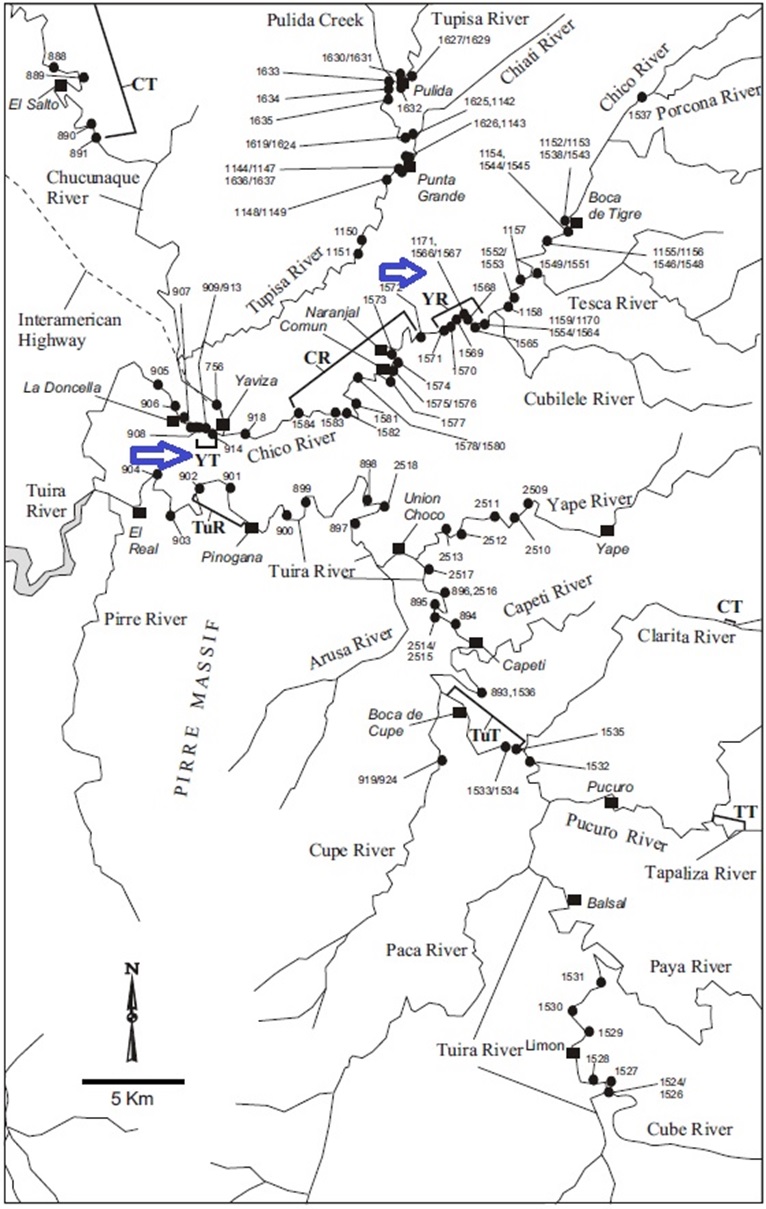Yaviza Fm
Period:
Neogene
Age Interval:
Upper Miocene (between 9.4 and 8.6 Ma) - Coates et al. (2004)
Province:
Eastern Panama
Type Locality and Naming
The Yaviza Fm is defined and named for the town of Yaviza, the eastern terminus of the Pan-American Highway, by Coates et al. (2004).
The stratotype of the Yaviza Fm lies on the northern bank of the Chucunaque River, downstream from the western edge of Yaviza (YT on Figure 1). A reference section is located on the Chico River below its junction with the Cubilele River (YR on Figure 1)
[Figure 1. Stratotype (YT) and Reference Section (YR) of the Yaviza Fm. Coates et al. (2004).]
Synonym:
Lithology and Thickness
The formation consists mainly of blue gray, massively bedded, pervasively bioturbated, shelly, lithic sandstone. The Yaviza Fm crops out in the central and eastern Chucunaque-Tuira Basin but thins westward and is not present in the Membrillo River section and beyond.
Thickness: The thickness of the Yaviza Fm ranges from 140m in the northwest to about 300m around Yaviza.
Lithology Pattern:
Sandstone
Relationships and Distribution
Lower contact
Membrillo Fm. The Yaviza’s lower contact is not observed.
Upper contact
Chucunaque Fm. The upper contact of the Yaviza Fm is not exposed and there is probably a hiatus above it of more than 1 m.y. in all sections, except the Membrillo River, where the base of the Chucunaque Fm is thought to be older than the rest of the formation and the Yaviza Fm is absent.
Regional extent
Eastern Panama
GeoJSON
{"type":"Feature","geometry":{"type":"MultiPolygon","coordinates":[[[[-79.61,9.61],[-79.48,9.64],[-79.23,9.6],[-78.99,9.56],[-78.49,9.45],[-78.08,9.29],[-77.84,9.09],[-77.4,8.7],[-77.35,8.59],[-77.3,8.42],[-77.18,8.02],[-77.26,7.82],[-77.39,7.66],[-77.56,7.46],[-77.73,7.31],[-77.83,7.24],[-77.89,7.24],[-78.01,7.33],[-78.25,7.61],[-78.38,7.9],[-78.43,8.14],[-78.4,8.31],[-78.51,8.49],[-78.64,8.67],[-78.88,8.86],[-79.18,8.99],[-79.35,9.03],[-79.37,9.04],[-79.42,9.09],[-79.52,9.13],[-79.52,9.17],[-79.54,9.21],[-79.54,9.3],[-79.54,9.35],[-79.62,9.34],[-79.7,9.33],[-79.8,9.41],[-79.75,9.49],[-79.61,9.61]]]]}}
Fossils
Oyster beds, ledging calcified hard beds, and irregular large concretions are scattered throughout. Abundant whole mollusks, sometimes forming shell beds, and dense shell hash are also distinctive. The uppermost part of the formation is characterized by coquinoid limestone units and densely packed, hard, shelly sandstone with shells often concentrated in burrows. Some shell beds are oyster banks, and others have large bivalves.
Age
The Yaviza Fm is placed in the middle part of the upper Miocene, based on the evidence from the upper Tuira River section. It falls within a 0.8 m.y. interval between 9.4 and 8.6 Ma.
Age Span:
Beginning stage:
Tortonian
Fraction up in beginning stage:
0.5
Beginning date (Ma):
9.44
Ending stage:
Tortonian
Fraction up in the ending stage:
0.7
Ending date (Ma):
8.56
Depositional setting
The Yaviza Fm is an inner neritic deposit. Benthic foraminifera are generally absent from the Tuquesa River, Tupisa River, and Chico River sections or are very poorly preserved. The Yaviza Fm near Yaviza appears to be a slightly deeper, middle neritic facies. The inner neritic taxa are less common, and species that live mostly deeper than 30 m are very abundant. Farther south, near the Cube River, the Yaviza Fm is an outer neritic facies.
Depositional pattern:
Additional Information
References: Coates et al. (2004)
Compiler:
Jacques LeBlanc (2021), Stratigraphic Lexicon: The Onshore Cenozoic Sedimentary Formations of The Republic of Panama. Biosis: Biological Systems, 2(1), 173 pp. https://doi.org/10.37819/biosis.002.01.0095 (or via https://sites.google.com/site/leblancjacques)
